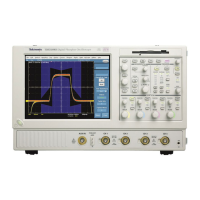265
| <UnaryOperator> ( <Expression> )
<BinaryExpression> := <Term> <BinaryOperator> <Term> | <Scalar>
<BinaryOperator> <Term> | <Term> <BinaryOperator> <Scalar>
<Term> := <Waveform> | ( <Expression> )
<Scalar> := <Integer> | <Float> | <Meas-Result>
<Waveform> := <ChannelWaveform> | <ReferenceWaveform> | <MathWaveform>
<ChannelWaveform> := Ch1 | Ch2 | Ch3 | Ch4
<ReferenceWaveform> := Ref1 | Ref2 | Ref3 | Ref4
<MathWaveform> := Math1 | Math2 | Math3 | Math4
<UnaryOperator> := Invert | Derivative | Integral | Average | Max | Min
| Filter | Vmag | Exp | log 10 | log e | sqrt | Spectral Magnitude
| Spectral Phase | Spectral Real | Spectral Imag
<BinaryOperator> := + | - | / | *
<Meas-Result> := meas1 | meas2 | meas3 | meas4 | meas5 | meas6 | meas7 | meas8
<Variable> = VAR1 |VAR2 |VAR3 |VAR4
Math Waveform Differentiation
The math capabilities of the instrument include waveform differentiation. This allows you to
display a derivative math waveform that indicates the instantaneous rate of change of the
waveform acquired.
Derivative waveforms are used in the measurement of slew rate of amplifiers and in educational
applications. You can create a derivative math waveform and then use it as a source for another
derivative waveform. The result is the second derivative of the waveform that was first
differentiated.
The math waveform, derived from the sampled waveform, is computed based on the following
equation:
Y
n = (X( n + 1 ) – Xn) 1/T
Where: X is the source waveform
Y is the derivative math waveform
T is the time between samples
Since the resultant math waveform is a derivative waveform (see the figure below), its vertical
scale is in volts/second (its horizontal scale is in seconds). The source signal is differentiated over
its entire record length; therefore, the math waveform record length equals that of the source
waveform.
